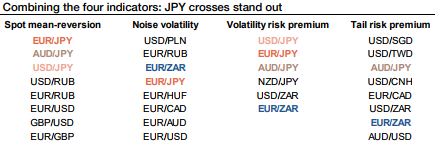Based on the combinations of four indicators, the suitable currencies are identified for the strongest patterns favouring a DNT trades.
The results are demonstrated in above table, where JPY crosses really stand out. EURJPY, AUDJPY, and EURZAR are identified by three or the four indicators.
EURUSD, USDJPY, EURCAD, EURRUB, and EURZAR are identified by two indicators. These pairs are likely to have interesting potential for DNT trades.
Spot mean reversion: Over the past six months, the ADF tests indicate that JPY crosses experienced strong mean reversion, as did RUB crosses. In G10, EURUSD, GBPUSD, and EURGBP are not very far from them. The least stationary pairs are TRY crosses.
Noise volatility: Realized volatility analysis shows that USDPLN experienced the most ‘noise’ volatility (as opposed to a volatility generating trends). This is also the case for a set of EUR crosses, against RUB, ZAR, JPY, HUF, CAD, AUD, and USD.
Volatility risk premium: Globally, EM volatility is more expensive than G10. In G10, JPY implied volatilities turn out to be by far the most expensive, in particular, the 6m and 1y expiries. In EM space, ZAR volatilities are very expensive. EURUSD, GBP and CAD volatilities are the cheapest.
Tail risk premium: Except the KRW, USD/Asia EM currencies have a low tail premium. This is also the case for JPY, ZAR or NZD crosses. USDKRW unsurprisingly has the biggest tail premium, reflecting geopolitical concerns. GBPUSD and USDCHF come almost just after, with the market still pricing Brexit tail risks for the former. EURMXN and EURUSD present some premium too. Courtesy: SG



 Mexico's Undervalued Equity Market Offers Long-Term Investment Potential
Mexico's Undervalued Equity Market Offers Long-Term Investment Potential  China's Refining Industry Faces Major Shakeup Amid Challenges
China's Refining Industry Faces Major Shakeup Amid Challenges  Oil Prices Dip Slightly Amid Focus on Russian Sanctions and U.S. Inflation Data
Oil Prices Dip Slightly Amid Focus on Russian Sanctions and U.S. Inflation Data  U.S. Banks Report Strong Q4 Profits Amid Investment Banking Surge
U.S. Banks Report Strong Q4 Profits Amid Investment Banking Surge  U.S. Stocks vs. Bonds: Are Diverging Valuations Signaling a Shift?
U.S. Stocks vs. Bonds: Are Diverging Valuations Signaling a Shift?  U.S. Treasury Yields Expected to Decline Amid Cooling Economic Pressures
U.S. Treasury Yields Expected to Decline Amid Cooling Economic Pressures  US Gas Market Poised for Supercycle: Bernstein Analysts
US Gas Market Poised for Supercycle: Bernstein Analysts  Geopolitical Shocks That Could Reshape Financial Markets in 2025
Geopolitical Shocks That Could Reshape Financial Markets in 2025  Gold Prices Fall Amid Rate Jitters; Copper Steady as China Stimulus Eyed
Gold Prices Fall Amid Rate Jitters; Copper Steady as China Stimulus Eyed  Urban studies: Doing research when every city is different
Urban studies: Doing research when every city is different  S&P 500 Relies on Tech for Growth in Q4 2024, Says Barclays
S&P 500 Relies on Tech for Growth in Q4 2024, Says Barclays 































